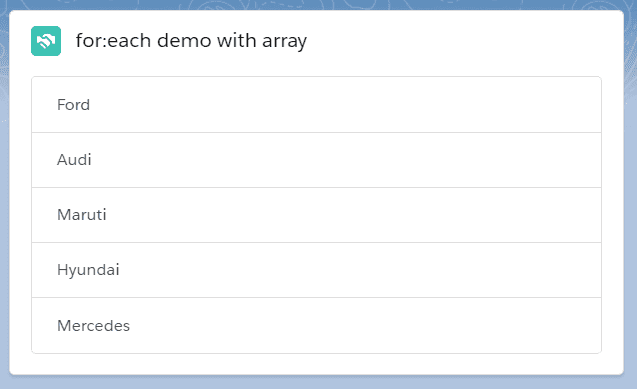for:each loop
There are many scenarios in which we have to render the same set of elements with the same styling with different data in the HTML. To solve this issue, we have template looping in the LWC.
There are are two types of directives by which we can achieve template looping.
1. for:each
2. iterator
use for:each directive or the iterator directive to iterate over an array.
for:each loop
Below is the syntax of the for:each loop
<template for:each={array} for:item="currentItem" for:index="index">
-----Here your repeatable template comes-----
</template>| Sno. | attributes | Description |
|---|---|---|
| 1. | for:each={array} | for:each takes the array as an input |
| 2. | for:item="currentItem" | currentItem is the value of the current element. currentItem is an alias and can be anyname. for:item holds the currentItem. |
| 3. | for:index="index" | index is the current element index in the array. for:index holds the index. |
what is key and it's importance in the loop
- A
keyis a special string attribute you need to include to the first element inside the template when creating lists of elements. - Keys help the LWC engine identify which items have changed, are added, or are removed.
- The best way to pick a key is to use a string that uniquely identifies a list item among its siblings.
Note- The key must be a string or a number, it can't be an object. You can't use the index as a value for the key.
Example of for:each template looping
- In VS Code, open the Command Palette by pressing
Ctrl+Shift+Pon Windows orCmd+Shift+Pon macOS. - Type
SFDXand SelectSFDX: Create Lightning Web Component. - Type
templateLoopingForEachas the name of the new component and pressEnter. - Again, Press
Enterto accept the defaultforce-app/main/default/lwc. - Goto your
lwcfolder, you will see one new component with the nametemplateLoopingForEachgets created. - Create one more file inside the folder
templateLoopingForEach.cssfor styling. -
Let's add the following code to
templateLoopingForEach.html,templateLoopingForEach.js,templateLoopingForEach.cssandtemplateLoopingForEach.js-meta.xml
import { LightningElement } from "lwc";
export default class TemplateLoopingForEach extends LightningElement {
carList = ["Ford", "Audi", "Maruti", "Hyundai", "Mercedes"];
programmingList = [
{
id: "06868",
language: "HTML"
},
{
id: "19797",
language: "CSS"
},
{
id: "298789",
language: "Javascript"
},
{
id: "398798",
language: "Apex"
},
{
id: "48967",
language: "Aura"
},
{
id: "58798",
language: "Java"
}
];
}<template>
<!-- Card for for:each demo with an array -->
<lightning-card title="for:each demo with array" icon-name="custom:custom14">
<ul class="slds-m-around_medium">
<template for:each={carList} for:item="car">
<a href="#" class="list-group-item list-group-item-action" key={car}
>{car}</a
>
</template>
</ul>
</lightning-card>
<hr />
<!-- Card for for:each demo with an array of objects -->
<lightning-card
title="for:each demo with array of objects"
icon-name="custom:custom14"
>
<ul class="slds-m-around_medium">
<template for:each={programmingList} for:item="program">
<a
href="#"
class="list-group-item list-group-item-action"
key={program.id}
>{program.language}</a
>
</template>
</ul>
</lightning-card>
</template>.list-group {
display: -ms-flexbox;
display: flex;
-ms-flex-direction: column;
flex-direction: column;
padding-left: 0;
margin-bottom: 0;
width: 50%;
}
.list-group-item:first-child {
border-top-left-radius: 0.25rem;
border-top-right-radius: 0.25rem;
}
.list-group-item-action {
color: #495057;
text-align: inherit;
text-decoration: none;
}
.list-group-item {
position: relative;
display: block;
padding: 0.75rem 1.25rem;
margin-bottom: -1px;
background-color: #fff;
border: 1px solid rgba(0, 0, 0, 0.125);
}
.list-group-item:last-child {
margin-bottom: 0;
border-bottom-right-radius: 0.25rem;
border-bottom-left-radius: 0.25rem;
}<?xml version="1.0" encoding="UTF-8"?>
<LightningComponentBundle xmlns="http://soap.sforce.com/2006/04/metadata" fqn="templateLoopingForEach">
<apiVersion>46.0</apiVersion>
<isExposed>true</isExposed>
<targets>
<target>lightning__AppPage</target>
<target>lightning__RecordPage</target>
<target>lightning__HomePage</target>
</targets>
</LightningComponentBundle>templateLoopingForEach.js-meta.xml
templateLoopingForEach.js-meta.xmlis a configuration file- The configuration file defines the metadata values for the component, including the design configuration for Lightning App Builder and Experience Builder.
- This file only show your component in app builder
you get an error, if you don’t include a configuration file for your component
for:each with Array demo explanation
- Inside the
templateLoopingForEach.htmlthe firstlightning-cardis for normal array demo for:eachis taking an ArraycarListwhich is a private property inside thetemplateLoopingForEach.js- we have used
caralias for the current item of an array and mapped it tofor:item - As
keyshould be unique and in this case, our all cars name is unique, so we have used their name as a key
for:each with an array of objects demo explanation
- Inside the
templateLoopingForEach.htmlthe secondlightning-cardis for array of objects demo for:eachis taking an ArrayprogrammingListwhich is a private property inside thetemplateLoopingForEach.js- we have used
programalias for the current item of an array and mapped it tofor:item - To access any property of an object, we have to use dot notation. for example
program.language - As key should be unique and in this case, we have a unique id for each object, so we are using
program.id templateLoopingForEach.cssyou can update based on your styling
Output
After placing the component on the page, you will see the following output.

